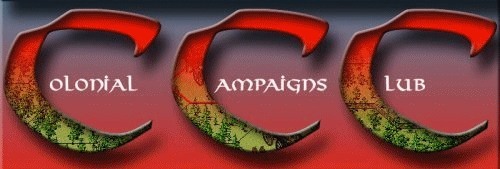 |
Colonial Campaigns Club (CCC)
|
 |
Colonial Campaigns Club (CCC)
|
|
All times are UTC - 5 hours [ DST ] |
Moderators: G Cope, SLudwig, Ernie Sands, Rich Hamilton, D.S. Walter
 
|
Page 1 of 2 |
[ 17 posts ] | Go to page 1, 2 Next |
|
| Author | Message | |||
|---|---|---|---|---|
| Al Amos |
|
|||
|
Joined: Tue May 22, 2001 6:38 pm Posts: 1414 Location: Broken Arrow, OK, USA |
|
|||
| Top | ||||
| ld5253 |
|
|||
|
Joined: Sat May 26, 2001 9:42 am Posts: 410 Location: USA |
|
|||
| Top | ||||
| Mike Cox |
|
|||
|
Joined: Wed Aug 08, 2001 12:39 am Posts: 791 Location: USA |
|
|||
| Top | ||||
| D.S. Walter |
|
||||
Joined: Wed May 23, 2001 6:41 am Posts: 1917 |
|
||||
| Top | |||||
| 676 |
|
|||
|
|
|
|||
| Top | ||||
| Stefan Reuter |
|
|||
|
Joined: Thu May 24, 2001 5:12 pm Posts: 227 Location: Germany |
|
|||
| Top | ||||
| Al Amos |
|
|||
|
Joined: Tue May 22, 2001 6:38 pm Posts: 1414 Location: Broken Arrow, OK, USA |
|
|||
| Top | ||||
| Mike Cox |
|
|||
|
Joined: Wed Aug 08, 2001 12:39 am Posts: 791 Location: USA |
|
|||
| Top | ||||
| Al Amos |
|
|||
|
Joined: Tue May 22, 2001 6:38 pm Posts: 1414 Location: Broken Arrow, OK, USA |
|
|||
| Top | ||||
| Gary McClellan |
|
|||
|
Joined: Sat Jul 14, 2001 1:13 am Posts: 658 Location: |
|
|||
| Top | ||||
| D.S. Walter |
|
||||
Joined: Wed May 23, 2001 6:41 am Posts: 1917 |
|
||||
| Top | |||||
| Gary McClellan |
|
|||
|
Joined: Sat Jul 14, 2001 1:13 am Posts: 658 Location: |
|
|||
| Top | ||||
| D.S. Walter |
|
||||
Joined: Wed May 23, 2001 6:41 am Posts: 1917 |
|
||||
| Top | |||||
| Mike Cox |
|
|||
|
Joined: Wed Aug 08, 2001 12:39 am Posts: 791 Location: USA |
|
|||
| Top | ||||
| Al Amos |
|
|||
|
Joined: Tue May 22, 2001 6:38 pm Posts: 1414 Location: Broken Arrow, OK, USA |
|
|||
| Top | ||||
 
|
Page 1 of 2 |
[ 17 posts ] | Go to page 1, 2 Next |
|
All times are UTC - 5 hours [ DST ] |
Who is online |
Users browsing this forum: No registered users and 8 guests |
| You cannot post new topics in this forum You cannot reply to topics in this forum You cannot edit your posts in this forum You cannot delete your posts in this forum You cannot post attachments in this forum |